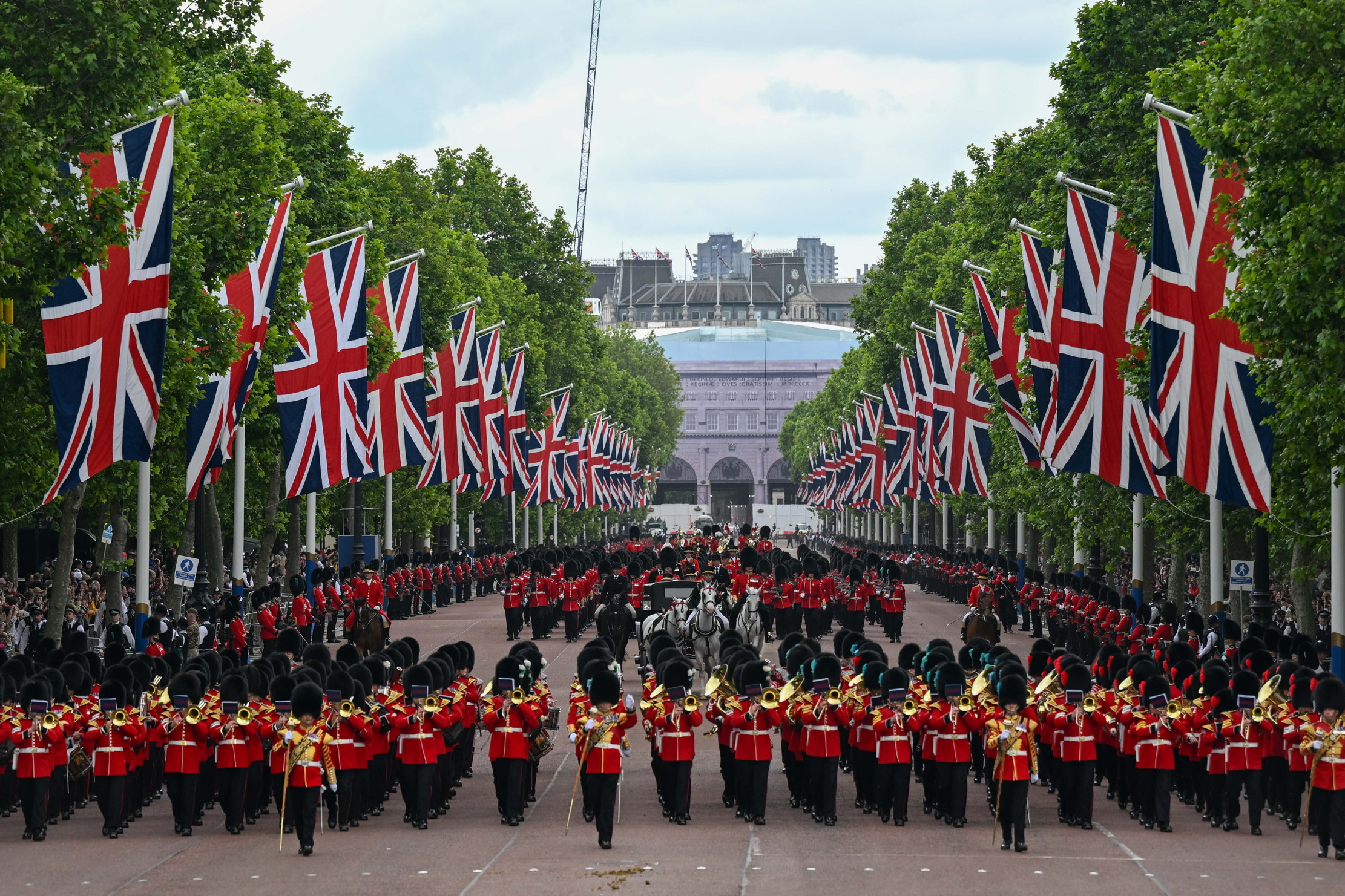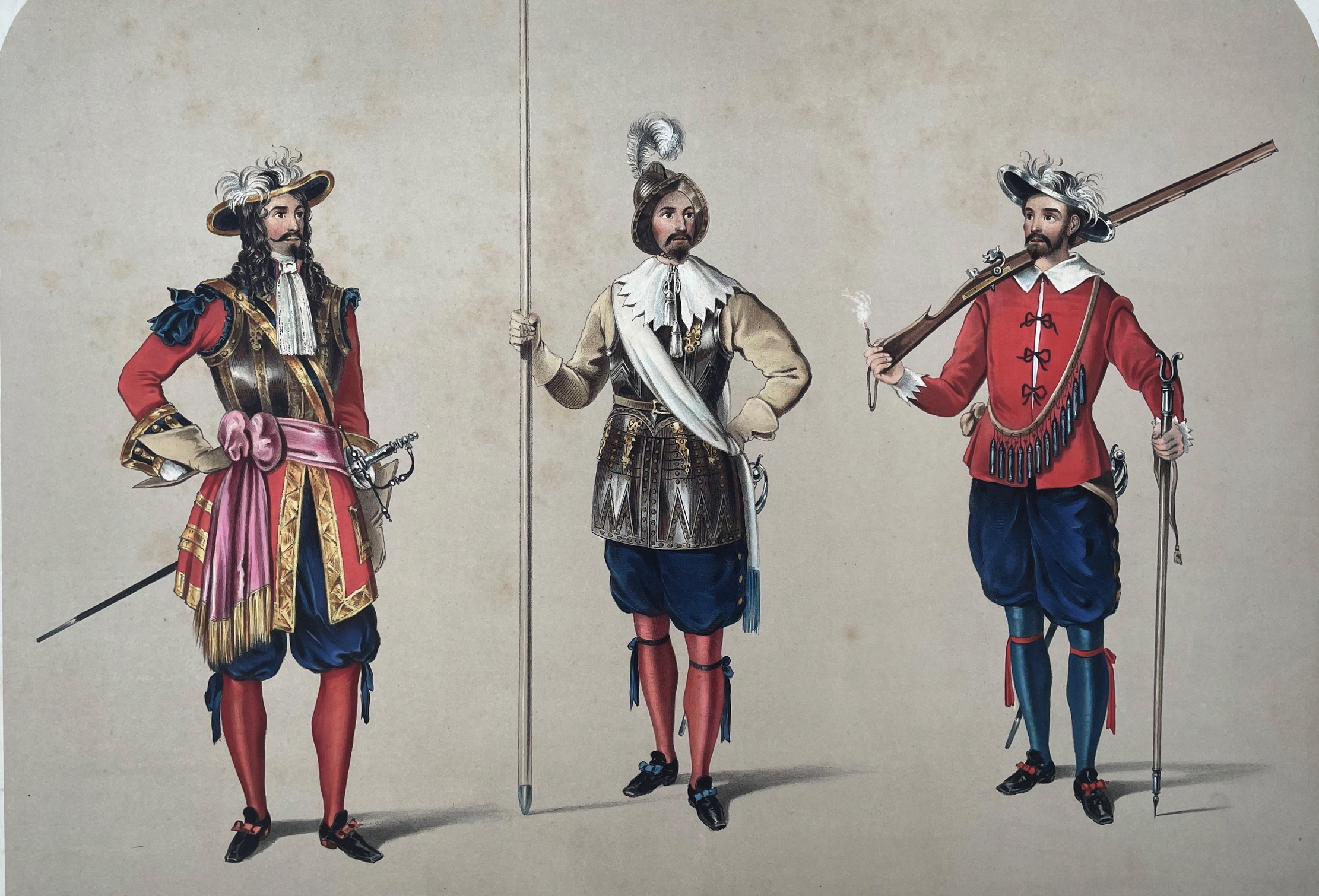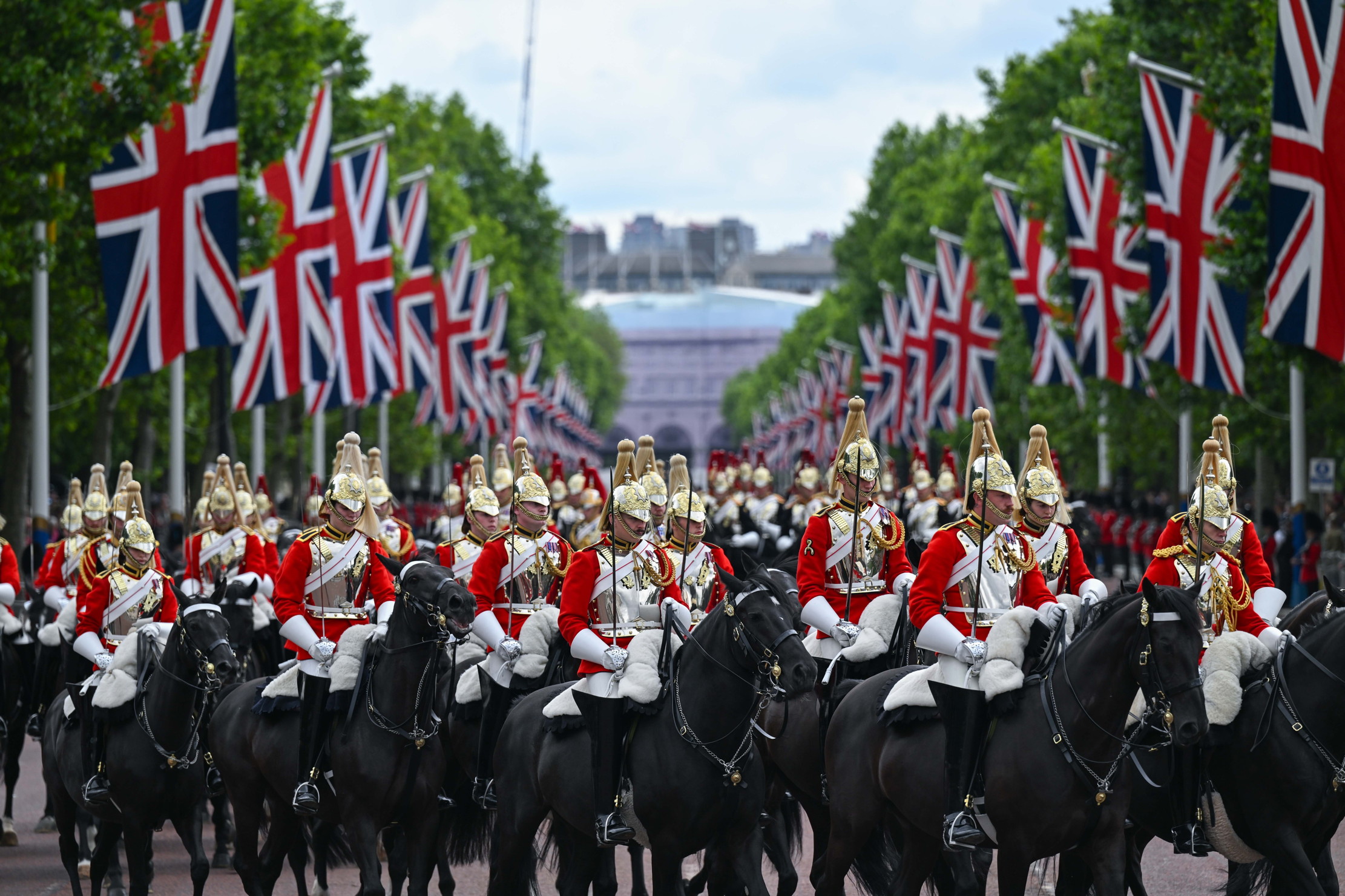Everything you could ever want to know about the uniforms of the British Army
From Cromwell's New Model Army to Waterloo to the King's Coronation, the outfits of our soldiers have always been as functional as they have been stylish.


Everyone loves colourful ceremonial uniforms. Together with the music and grandeur of a great State occasion, the sight of mounted and marching soldiers in formation is the essence of pomp and circumstance. By contrast, the camouflage uniforms that soldiers wear on operations are designed with the opposite in mind. They blend with their surroundings: a windswept desert, a dense jungle or an inner-city battleground. Yet uniforms were not always like that, in design or purpose.
As Allan Mallinson explains in The Making of The British Army, it was in the New Model Army, Britain’s first standing army formed in 1645, that British soldiers began to ‘wear a true uniform — red’. Oliver Cromwell knew the type of officers he wanted: ‘I had rather have a plain russet-coated Captain that knows what he fights for, and loves what he knows, than what you call a Gentleman and is nothing else.’ There was no place in this new army for those who were officers merely because they were Members of Parliament.
Why did British soldiers wear red coats in the field rather than clothing more appropriate to their surroundings and why did this practice continue until the late 19th century? To hide the wounds of soldiers on the battlefield, to intimidate the enemy or as a simple form of recognition? In an era when armies fought at close quarters and often hand-to-hand, it was important to be recognised as friend or foe.

None of these theories, however plausible, explain fully why British soldiers wore red uniforms in the field for more than 300 years and why these now form the origin of ceremonial dress. The reason, certainly in the early days, was that the most readily available dyes for uniforms were red. The dyeing process for these pigments was simple and, following the old maxim about military equipment always being purchased from the least-expensive supplier, so it was for uniforms: red was cheap.
The New Model Army was a formidable fighting force, but it was not known for sartorial elegance. The soldiers’ uniforms were hewn from rough cloth and the dyeing process used to create their colour was of an inconsistent quality. Cromwell’s ‘russet’ description was a good one: more a mixture of yellow and brown than scarlet. What had changed was that soldiers now wore a uniform. The Roundheads may not have struck the pose of a medieval knight in shining armour, but at least they were recognisable as part of a disciplined army.
This tradition of red uniforms soon became part of the institution itself, even beyond the time when wearing a scarlet tunic had become risky on the battlefield. Redcoats, as they were known, fought in all the major campaigns of the 17th, 18th and 19th centuries, a period when the army was rarely regarded as a favoured career for young men. When the future Field Marshal ‘Wully’ Robertson enlisted as a private soldier in 1877, his mother was ‘ashamed to think of it. I would rather bury you than see you in a red coat’. For those men who did join, a smart uniform was important, together with the esprit de corps of regimental life and the military music that lifted morale as soldiers marched into battle.
'Any deviation from the approved Patterns in any respect whatsoever, without due authority... will incur Her Majesty's displeasure'
The idiosyncrasies of military dress began to emerge in 1660, when Charles II returned from exile, escorted by his recently raised Life Guards and Grenadiers in uniforms more eye-catching than those of the New Model Army. The Restoration heralded a far more colourful era and, although officers and soldiers wore red, blue and green tunics both on parade and on the battlefield, styles across the different regiments varied considerably. Aristocrats and gentlemen commanded their regiments and were keen to make their uniforms different, often footing the bill.
Sign up for the Country Life Newsletter
Exquisite houses, the beauty of Nature, and how to get the most from your life, straight to your inbox.
The British Army published its official dress regulations in 1833, but these were often ignored, prompting the Duke of Wellington, in 1846, to warn colonels that any deviation ‘from the approved Patterns in any respect whatsoever, without due authority… will incur Her Majesty’s displeasure’. The current Army Dress Regulations are now more than 1,200 pages in length; hardly bedtime reading, they are comprehensive. Each part of the army has its own uniforms and facings, badges, headgear and accoutrements.
At State events, soldiers of the Household Division (the Household Cavalry and the Foot Guards) parade in red, blue and gold uniforms. Ceremonial events in previous centuries would have looked remarkably similar, albeit perhaps not as precisely choreographed as they now are. The all-seeing eye of the television lens can be as unforgiving as any enemy.
Household Division uniforms on parade today are much the same as those worn in 1838, at the coronation of Queen Victoria. The significant difference, however, is that, in the 19th century, these were also worn on the battlefield. The uniforms worn at Elizabeth II’s funeral in 2022 and Charles III’s coronation in 2023, from the fine detail that differentiates the five regiments of Foot Guards to the cuirasses and helmets of the Household Cavalry, have their origins in warfare, not the parade ground. Yet it is there, far removed from the battlefield, that the tradition continues.
It was at the Battle of Waterloo, in 1815, that the First Regiment of Foot Guards acquired the name Grenadiers, in recognition of their defeat of the Grenadiers of the French Imperial Guard. The Grenade was adopted as a badge, as was the black bearskin cap, similar to that worn by the French. In 1833, the Coldstream and the Scots Guards were granted the honour of wearing the bearskin, as were the Irish and Welsh Guards on formation in 1900 and 1915.
At a distance and as a massed formation, the differences between the uniforms of the five regiments of Foot Guards are difficult to spot. Take, for example, the plumes on the bearskins, which are distinct in composition and colour. The Scots Guards have no plume at all because, when they form up with the other four regiments, they take the centre line.

The mounted troops of the Life Guards wearing red tunics and the Royal Horse Guards in blue (hence ‘The Blues’) charged at Waterloo against the French Cuirassiers, but, unlike the French, they were not wearing back and breast plates or cuirasses, although the Life Guards had worn something similar in the mid 17th century. Cuirasses were a useful form of protection, as they could deflect the blade of a heavy cavalry sword, but it wasn’t until 1821 that these were introduced for the Household Cavalry and this was more as a battle honour for defeating the French Cuirassiers than as armour.
By this time, a prolonged period of peace had descended across Europe, so the Household Cavalry never wore cuirasses in battle, although, on parade, they continue to wear them to this day and to a similar pattern as the original. The same may be said for the helmets. The Albert pattern helmet, worn by The Life Guards and The Blues and Royals, was introduced by Queen Victoria in 1842 and remains in use.
Across their scarlet full-dress tunics, Foot Guard officers wear a crimson-and-gold sash with a gold fringe made of individual tassels. The sash’s original purpose on the battlefield was practical, rather than decorative: it could be used as a makeshift stretcher, each tassel denoting a member of the officer’s platoon or company. If a soldier was killed or wounded, his officer detached a tassel from his sash, attaching it to the soldier before he was borne from the field. In this way, he was able to keep a tally of those he had lost, leaving the correct number for the purpose of pay and provisions.
'Their faux-fur busby hats, topped by a plume like a tightly furled shaving brush, were designed to serve as a bucket, too'
As the Foot Guards march onto Horse Guards Parade on June 15 for The King’s Birthday Parade (Trooping the Colour), it will not require a huge flight of fancy for the spectators to summon up a vision from another century. When the Guards Brigade advanced uphill to attack the Russian infantry at the Battle of the Alma, in September 1854, they were wearing their bearskins, scarlet tunics and deep blue and red trousers that they wear now. The Grenadiers, Coldstream and Scots Guards, who stood shoulder-to-shoulder at the Alma, with rifles and fixed bayonets, will be on Horse Guards doing the same, together with the Irish and Welsh Guards.
Following the Troop itself — where, this year, it will be the Irish Guards’ Colour on parade — the King’s Troop Royal Horse Artillery will take centre stage, with their First World War guns, to fire the 41-gun salute in Green Park. The King’s Troop is dressed in a lighter style of uniform than the Household Cavalry: tight-fitting, dark-blue tunics, lined in pigskin, with gold braid frogging across the chest, designed in the 18th century to protect the wearer from sword strikes. Their faux-fur busby hats, topped by a plume like a tightly furled shaving brush, were designed to serve as a bucket, too.
Thankfully, soldiers are no longer required to fight in the splendid uniforms they will wear at Trooping the Colour. That’s not to say they will have an easy time: the uniforms will be worn with immense pride, but also for a long time. We must hope that the weather is kind — not too hot or, indeed, wet.
Simon Doughty is the author, with Paul de Zulueta, of ‘Those Must Be The Guards: The Household Division in Peace and War, 1969–2023’
Country Life is unlike any other magazine: the only glossy weekly on the newsstand and the only magazine that has been guest-edited by HRH The King not once, but twice. It is a celebration of modern rural life and all its diverse joys and pleasures — that was first published in Queen Victoria's Diamond Jubilee year. Our eclectic mixture of witty and informative content — from the most up-to-date property news and commentary and a coveted glimpse inside some of the UK's best houses and gardens, to gardening, the arts and interior design, written by experts in their field — still cannot be found in print or online, anywhere else.
-
 'Monolithic, multi-layered and quite, quite magnificent. This was love at first bite': Tom Parker Bowles on his lifelong love affair with lasagne
'Monolithic, multi-layered and quite, quite magnificent. This was love at first bite': Tom Parker Bowles on his lifelong love affair with lasagneAn upwardly mobile spaghetti Bolognese, lasagne al forno, with oozing béchamel and layered meaty magnificence, is a bona fide comfort classic, declares Tom Parker Bowles.
By Tom Parker Bowles
-
 Country houses, cream teas and Baywatch: Country Life Quiz of the Day, April 24, 2025
Country houses, cream teas and Baywatch: Country Life Quiz of the Day, April 24, 2025Thursday's Quiz of the Day asks exactly how popular Baywatch became.
By Toby Keel